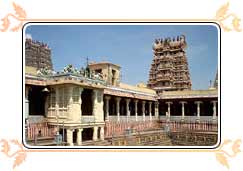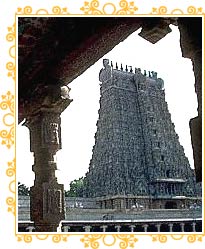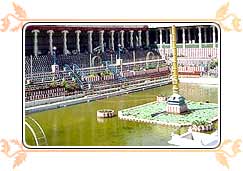

Meenakshi Temple, Madhurai, Tamil Nadu
Preamble:
A diamond is radiant and brilliant because of its facets. It reflects and refracts light to produce a spectacular show of color and light that makes it the most desirable of all the jewels. Hinduism is very much like that diamond, multifaceted, brilliant and reflects the human mind in all its glory. No one facet of Hinduism could account for all its grandeur.
Hinduism is also very vast and fathomless. When we study Hinduism, we are like the five blind men who went to 'see' the elephant. We form our own idea of what Hinduism is all about and tend to be dogmatic about it. Some consider Hinduism to be all about the pantheon of Gods with extranumerary arms, anthropomorphic idols, and bestial featured curiosities. Others think of it as a cult of naked sadhus and saffron clad baldies jumping up and down in the airport lounges peddling books.
Then there are the ashram-tycoons floating around in Rolls Royces and private jets professing the power of organized religion.
None of this truly represents Hinduism but all are part of it. Our religion is this and much more. It may not even be called a religion, it represent a way of life that evolved over thousands of years and has gathered so much of human history, tradition, culture, and the greatness and meanness of the intellectual and the commoner. The schools are myriad and dogma rampant. There is intellectual Hinduism lashed out in voluminous books and dished out in erudite conferences and there is the practical Hinduism of the day-to-day life of the masses.
A student of Hinduism is like a child let loose in a candy shop, attracted to the colorful and the catchy display and the flavor of the day. However, soon he will realize where the true sweetness lies and it may not be the best looking one.
This is a birds-eye-view of Hinduism and you may not agree or accept everything that is said here. Hinduism lends itself to difference in views and thoughts and disagreements. There lies its strength. It has no barriers and all are welcome.
In a nutshell:
The universal guiding principles on which Hinduism is based are:
Truth (Satyam), Compassion towards all (Ahimsa), Social norms (Dharma), Tolerance, Duty and Self-control.
Who is the Authority?
God alone is the authority.
Since we cannot directly converse with God, His words are considered authority. The Shruthies or Vedas are a compilation of thoughts of the seers and sages who were in close communion with Nature or God. They are collected into the four, Rig, Yajur, Sama, and Atharvana Vedhas by the sage Vedha Vyasa. They are all very ancient and are handed down to us by generations of our forefathers memorizing the details and reproducing it for us. The Vedhas are in the Sanskrit language and they deal with nature, Gods, rituals, the nature of Self and the duties of Human beings. The end sections appended to each Vedha are the Vedhanta or the Upanishads, which extensively deals with the nature of God, creation and the attributes of the universe.
There is no founder for Hinduism. No body could ascertain when it started and by who. It has evolved over the eons to the present state. There is no one “Bible” for Hinduism, as there are many “Bibles”. Some consider the Upanishads as their sourcebook and others The Bhagavat Githa or the Thirukkural and so on. There are many schools and many texts and claim any one as “The Book” and to discredit others is an exercise in foolishness. There are practicing Hindus all over the world, speaking different languages and living a Hindu life that is slightly different from others. When a spiritual idea becomes a religion, it loses some its open mindedness and becomes obsessed with self-preservation.
The Hindu Gods:
They are many. Some are women, some are men, some are animals and some have no form. Why are there hundreds of Gods? Think for a moment that there is only McDonalds and no other restaurant and they only serve cheeseburger. How would that be? Why are there churches of many denominations on a single street though they all worship the same God? It is a mere reflection of how human beings think. Each one has a different goal, needs and aspirations and so everyone needs a personal God to appeal to. In Hinduism, thought is free. As a matter of fact, even atheism is an integral part of Hindu Philosophy.
Why do Hindus worship animals?
We not only worship animals, but we also worship stones, rocks, mountains, rivers, the Sun, the planets, fire, water, wind, earth, space, the arts, the ancestors and other useless items. They are all part of our life and are benefactors and destroyers of our happiness. We are at their mercy, so we worship them.
What is Hindu view of creation?
There are many views. The earlier view is that the universe is a manifestation of God himself. What we see as matter and world are considered by some as Maya or illusion. Others consider them distinct from God. There is also a strong acceptance of the evolution of matter into living being. The later theory is that Brahma as a creator projected himself in the universe. He spent his Bhrahma day (4320 million human years) creating and his entire night dissolving or absorbing his creation. The creation and absorption cycle goes on and on. Each cycle is called a Kalpam.
Reincarnation and Karma:
Everything is created, dissolved and created again. When a living being dies, its soul continues to remain and appears in another form. According to the Law of Karma, man has several births and deaths. He is responsible for his action in the present life. Good deeds lead to better life in the next birth and vice versa. Deliverance from the cycle of birth and death through good deeds is Moksha or Heaven. Suffering in one's present life is because of misdeed in his previous births, i.e., ‘bad karma'.
The name, “Hinduism”:
The term Hinduism is of late coinage. When the invaders crossed the river Sindhu in northwest India , the terms Hindu and India were created. The names,“Vaideeka Dharma”(religion of the Vedas) and “Sanatana Dharma”(eternal religion) are more representative of our way of life. Similarly, India 's original name was Bharat or Baratha varsha (the land of Bharatha , the son of King Dhushyantha and Sakunthala who is the daughter of sage Viswamithra and Menaka).
 The Origin Of The Meenakshi Temple
The Origin Of The Meenakshi TempleThe Sri Meenakshi Sundareswara temple and Madurai city originated together. According to tradition, Indra once committed sin when he killed a demon, who was then performing penance. He could find no relief from remorse in his own kingdom. He came down to earth. While passing through a forest of Kadamba trees in Pandya land, he felt relieved of his burden. His servitors told him that there was a Shivalinga under a Kadamba tree and beside a lake. Certain that it was the Linga that had helped him; he worshipped it and built a small temple around it. It is believed that it is this Linga, which is till under worship in the Madurai temple. The shrine is called the "Indra Vimana".
Once Dhananjaya, a merchant of Manavur, where the Pandyas had arrived after the second deluge in Kumari Kandam, having been overtaken by nightfall in Kadamba forest, spent the night in the Indra Vimana. When next morning he woke up, he was surprised to see signs of worship. Thinking that it must be the work of the Devas, he told the Pandya, Kulasekhara, in Manavur, of this. Meanwhile Lord Shiva had instructed Pandya in a dream to build a temple and a city at the spot Dhananjaya would indicate. Kulasekhara did so. Thus originated the temple and city.
Earliest References Of The Temple
Paranjothi Munivar wrote the Tiruviayadal Puranam in the sixteenth century. It is regarded as the temple's Sthalapurana. An earlier work adds a few celestial sports not included in the latter. These are, or rather were painted on the walls around the Golden Lily Tank. Some of the painted wooden panels are in the Temple Museum.
The earliest references available to any structure in this temple is a hymn of Sambhandar's, in the seventh century, which refers to the "Kapali Madil". The present inner walls of the Lords shrine bear this name today. In the early times the entire temple must have been confined to the area between these walls, and the structures must have been of brick and mortar.
In the 14th century an invasion by Malik Kafur damaged the temple. In the same century Madurai was under Muslim rule for nearly fifty years. The temple authorities closed the sanctum, covered up the Linga, and set up another in the Ardhamandapa. When the city was liberated, the sanctum was opened, and, tradition says the flower garlands and the sandalwood paste placed on the Linga were as fresh as on the first day, and two oil lamps were still burning.
|
Major Festivels Celebrated at Madurai
|
How to Get there
|
 | Related Tour Packages
|
 The Golden Lily Tank
The Golden Lily Tank

0 comments:
Post a Comment